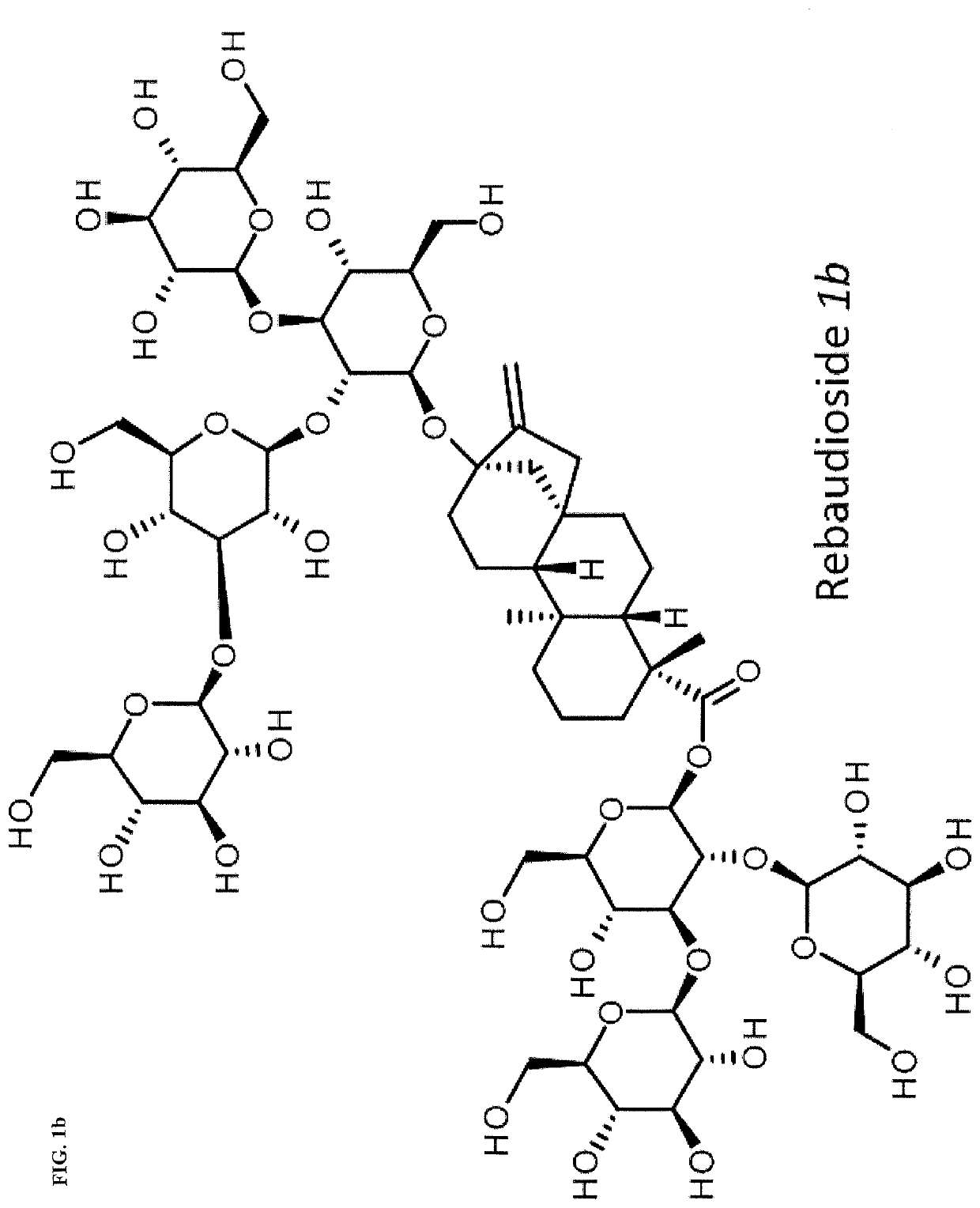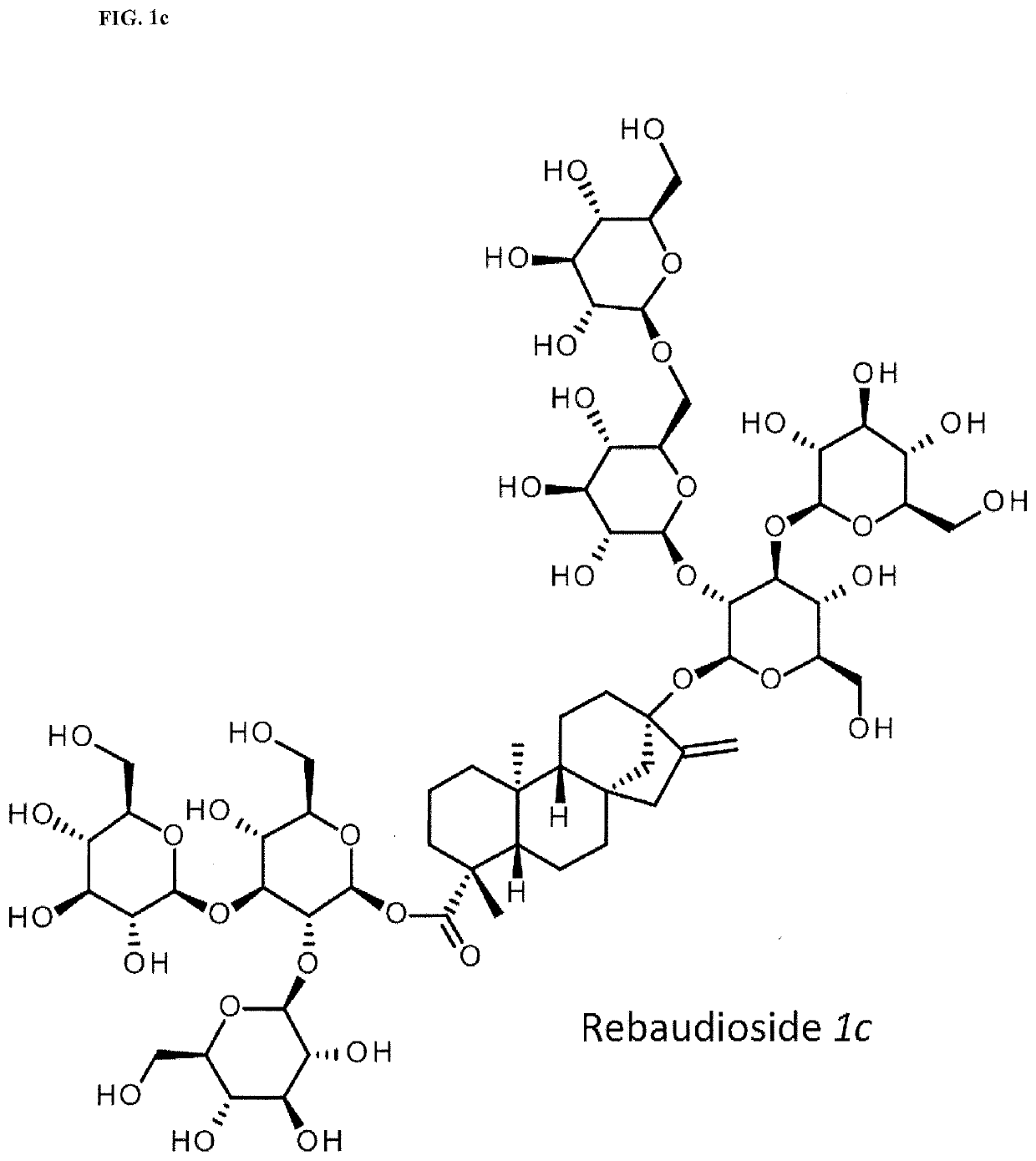High-purity steviol glycosides
a technology of steviol glycosides and steviol, which is applied in the field of preparation of compositions comprising steviol glycosides, can solve the problems of unsuitable commercial use of methods
- Summary
- Abstract
- Description
- Claims
- Application Information
AI Technical Summary
Benefits of technology
Problems solved by technology
Method used
Image
Examples
example 1
Protein Sequences of Engineered Enzymes Used in the Biocatalytic Process
[0699]
SEQ ID 1:>SuSy_At, variant PM1-54-2-E05 (engineered sucrosesynthase; source of WT gene: Arabidopsis thaliana)MANAERMITRVHSQRERLNETLVSERNEVLALLSRVEAKGKGILQQNQIIAEFEALPEQTRKKLEGGPFFDLLKSTQEAIVLPPWVALAVRPRPGVWEYLRVNLHALVVEELQPAEFLHFKEELVDGVKNGNFTLELDFEPFNASIPRPTLHKYIGNGVDFLNRHLSAKLFHDKESLLPLLDFLRLHSHQGKNLMLSEKIQNLNTLQHTLRKAEEYLAELKSETLYEEFEAKFEEIGLERGWGDNAERVLDMIRLLLDLLEAPDPSTLETFLGRVPMVFNVVILSPHGYFAQDNVLGYPDTGGQVVYILDQVRALEIEMLQRIKQQGLNIKPRILILTRLLPDAVGTTCGERLERVYDSEYCDILRVPFRTEKGIVRKWISRFEVWPYLETYTEDAAVELSKELNGKPDLIIGNYSDGNLVASLLAHKLGVTQCTIAHALEKTKYPDSDIYWKKLDDKYHFSCQFTADIFAMNHTDFIITSTFQEIAGSKETVGQYESHTAFTLPGLYRVVHGIDVFDPKFNIVSPGADMSIYFPYTEEKRRLTKFHSEIEELLYSDVENDEHLCVLKDKKKPILFTMARLDRVKNLSGLVEWYGKNTRLRELVNLVVVGGDRRKESKDNEEKAEMKKMYDLIEEYKLNGQFRWISSQMDRVRNGELYRYICDTKGAFVQPALYEAFGLTVVEAMTCGLPTFATCKGGPAEIIVHGKSGFHIDPYHGDQAADLLADFFTKCKEDPSHWDEISKGGLQRIEEKYTWQIYSQRLLTLTGVYGFWKHVSNLDRLEHRRYLEMFYALKYRPLAQAVPLAQDDSE...
example 2
Expression and Formulation of SuSy_At Variant of SEQ ID 1
[0700]The gene coding for the SuSy_At variant of SEQ ID 1 (EXAMPLE 1) was cloned into the expression vector pLETA17 (derivative of pRSF-1b, Novagen). The resulting plasmid was used for transformation of E. coli BL21(DE3) cells.
[0701]Cells were cultivated in ZYM505 medium (F. William Studier, Protein Expression and Purification 41 (2005) 207-234) supplemented with kanamycin (50 mg / l) at 37° C. Expression of the genes was induced at logarithmic phase by IPTG (0.2 mM) and carried out at 30° C. and 200 rpm for 16-18 hours.
[0702]Cells were harvested by centrifugation (3220×g, 20 min, 4° C.) and re-suspended to an optical density of 200 (measured at 600 nm (OD600)) with cell lysis buffer (100 mM Tris-HCl pH 7.0; 2 mM MgCl2, DNA nuclease 20 U / mL, lysozyme 0.5 mg / mL). Cells were then disrupted by sonication and crude extracts were separated from cell debris by centrifugation (18000×g 40 min, 4° C.). The supernatant was sterilized by f...
example 3
[0704]Expression and formulation of UGTS12 variant of SEQ ID 2 The gene coding for the UGTS12 variant of SEQ ID 2 (EXAMPLE 1) was cloned into the expression vector pLE1A17 (derivative of pRSF-1b, Novagen). The resulting plasmid was used for transformation of E. coli BL21(DE3) cells.
[0705]Cells were cultivated in ZYM505 medium (F. William Studier, Protein Expression and Purification 41 (2005) 207-234) supplemented with kanamycin (50 mg / l) at 37° C. Expression of the genes was induced at logarithmic phase by IPTG (0.1 mM) and carried out at 30° C. and 200 rpm for 16-18 hours.
[0706]Cells were harvested by centrifugation (3220×g, 20 min, 4° C.) and re-suspended to an optical density of 200 (measured at 600 nm (OD600)) with cell lysis buffer (100 mM Tris-HCl pH 7.0; 2 mM MgCl2, DNA nuclease 20 U / mL, lysozyme 0.5 mg / mL). Cells were then disrupted by sonication and crude extracts were separated from cell debris by centrifugation (18000×g 40 min, 4° C.). The supernatant was sterilized by fi...
PUM
| Property | Measurement | Unit |
|---|---|---|
| weight | aaaaa | aaaaa |
| weight | aaaaa | aaaaa |
| weight | aaaaa | aaaaa |
Abstract
Description
Claims
Application Information
 Login to View More
Login to View More - R&D
- Intellectual Property
- Life Sciences
- Materials
- Tech Scout
- Unparalleled Data Quality
- Higher Quality Content
- 60% Fewer Hallucinations
Browse by: Latest US Patents, China's latest patents, Technical Efficacy Thesaurus, Application Domain, Technology Topic, Popular Technical Reports.
© 2025 PatSnap. All rights reserved.Legal|Privacy policy|Modern Slavery Act Transparency Statement|Sitemap|About US| Contact US: help@patsnap.com



